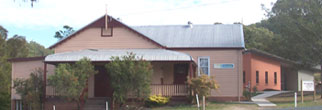Kendall School of
Arts
The Kendall School
of Arts, a much loved building, has been the focus of many district
activities for nearly a century. It is well built of local timber,
indicative of the timber industry which was the major local industry
for approximately one hundred years.
The site of today’s
Kendall Community Centre was initially notified as Camping Reserve
No 132 on 1 August 1881. The Camping Reserve was used to rest horses
and bullock teams after they drew logs from the forests to the Kendall
timber mills.
 Kendall School of Arts Grand
Opening in 1910
Kendall School of Arts Grand
Opening in 1910 |
In 1892 the land was excised from the Camping Reserve and ‘proposed to be set apart as a site for School of Arts at Kendall (Private Village)’. But it was not until sixteen years later, in 1908, that local residents began erecting the building with donated timber. The Kendall School of Arts was officially opened on 24 May 1910. It is one of at least seven surviving Schools of Arts within an eighty kilometre radius that was built between Federation and World War I. The traditional role of Schools of Arts was to provide venues for lectures, classes and libraries for the “useful knowledge” and “mental and moral improvement” of the working class.
In the early twentieth century
Schools of Arts were important social and political meeting
places as well as places of entertainment such as social
evenings, debutante balls and concerts. Although there are
occasional references to ‘Literary Institute’
and ‘Mechanics’ Institute’ in some documents,
the name School of Arts remained in official use in Kendall
until 1984.
|
It was a venue for
the moving pictures of the day when large film canisters were unloaded
from the train at Kendall Station to be collected by such entrepreneurs
as Keever’s Touring Talkies during the 1930s, and later by
A.E. Gibson, John Hatsistouris and Bruce Longworth.
The late Bob Boyd
remembered with great nostalgia the concert Slim Dusty gave c.1950
following release of his new record album. The hall was full to
overflowing and people were sitting in chairs all around the verandah.
Ian Bailey also
remembers the occasion well, he was about seven years old. There
was a flood and, as he and a mate raced to get to the performance,
they fell into the creek. They arrived at the hall soaking wet and
dripping water all over the floor. They slipped in through the crowd
and moved around the wall to see and hear better. Slim saw them
and called out ‘You young fellas had better come and sit up
here’ and the two wet boys excitedly went forward and sat
on the front of the stage for the whole of the concert. Ian remembers
seeing Slim’s old black car (a Buick or Chevy) with huge bulls
horns wired on the front.
Following the loss
of the School of Arts' supper room roof during a gale in 1983, the
School of Arts was unable to be used as the poling booth for the
looming major election. The Management Committee held a referendum
outside the War Memorial Rooms being used as the alternative booth.
Five options were given: sale; total demolition for a park; demolition
and replacement with a new building; essential repairs; complete
restoration. The vote was overwhelming in favour of complete restoration.
In 1984 advice was
received from the NSW Premier’s Department that the name School
of Arts did not fit with the use of the building and a more appropriate
category was ‘community centre’ or ‘neighbourhood
house’. Advice was received that, if the name were changed,
the hall would come under the auspices of the Department of Community
Services which would assist with securing funding to restore the
building.
Because grant funding
was crucial to the community’s desire to restore the building,
the name was duly changed to Kendall Community Centre. Many residents
resisted the new name and continued to call it the School of Arts,
believing that the change detracted from the building’s heritage
significance.
 Kendall School of Arts before
restoration in1981
Kendall School of Arts before
restoration in1981 |
Substantial
funding for the restoration came from the Commonwealth Government
and, despite the loss of the building’s historic name,
from the Heritage Branch of the New South Wales Government
who listed the entire site for its significance. Hastings
Council also assisted in this major undertaking. Once again,
local residents gave unstintingly of their time and money.
They undertook not only major fund raising but also much of
the physical work of the restoration. When a new Board of
Trustees was established, some of those involved were appointed
as custodians of the property they had helped to rescue. One
of them, Frank Kandilas, later extended the stage, making
it suitable for major performances. |
|
Whether School
of Arts or Community Centre, it is often still called, affectionately,
Kendall Hall. It fulfilled, and continues to fulfil, all the
traditional functions of a School of Arts. The Camden Haven
Learning Exchange was established there in 1982, to move in
1991 to Laurieton as Camden Haven Adult and Community Education.
Kendall Community Pre-School was established in 1988 and operated
in the Supper Room for several years. Hastings Council housed
a small library, open twice a week, in one of the two side
rooms until 1989. The other room was used for small meetings,
a weekly Women’s Resource Centre and a part-time office
in which a local solicitor established his business, after
which the two side rooms were refurbished to become a consulting
suite for a local G.P. Currently these side rooms are occupied
by the Community Technology Centre which was established in
2003.<
Kendall School
of Arts is in full time use. Many different community activities
and meetings are held there and its superb acoustics are widely
admired. It is the home of several major events and festivals
and remains the social and cultural hub of the district.
Physical
Description
The symmetrical T-shaped School of Arts building occupies
a commanding site at the top of the village shopping centre.
It is well sited on a sloping triangular piece of land which
addresses the Y intersection of Comboyne and Albert Streets.
The apex of the triangle is truncated by an unofficial road
on the eastern side. The adjacent Kendall War Memorial, c.1919,
and surrounding open space complements the hall site while
intersecting the view from the shopping centre.
The hall is
dug into the ground on the northern (Comboyne Road) side and
is high off the ground on the southern (Albert Street) side.
A supper room is attached on the southern elevation. The rear
of the building has lesser add-ons of stage and dressing rooms.
|
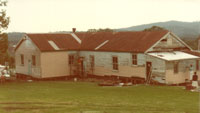
Northern view before restoration
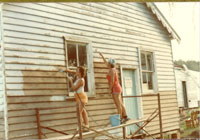
Commonwealth Employment Scheme
workers helping with restoration
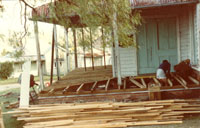
Restoration work
|
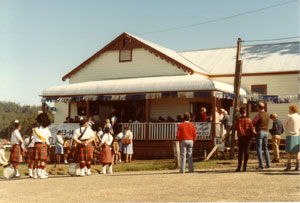
Re-opening in 1980s |
In 1973 the former one-roomed
Batar State School was moved to the rear of the site for the
use of the ‘youth of the district’. It occupies
the site of a former nineteenth century cottage. In 2005,
a new building to house a Rural Transaction Centre, was completed
on the site with funding from the Commonwealth Department
of Transport and Regional Services.
Materials
chosen for the new building are intrinsically simple: brick
veneer walls on south-east and north-east elevations; north-west
and south-west elevations are of reverse brick veneer with
the exterior clad in horizontal custom orb in a colorbond
finish. The brickwork is rendered to provide a transition
between the 1908 building and the new building materials. |
The roof, a hipped
structure with a hip running from a high point on the eastern end
to a low point at the west is, at its greatest height, lower than
the ridge of the School of Arts roof. It sits comfortably next to
the School of Arts and is sympathetic with the village context.
The vista from the
front of the School of Arts encompasses the mix of residential,
commercial and industrial buildings that is the centre of the village
of Kendall. Similarly, it dominates the view up the hill from the
shopping centre. The dwellings on Comboyne and Albert Streets opposite
are predominantly turn-of-the-century timber cottages, some with
Victorian detailing.
Only one other listed
building, an outstanding Federation house, is adjacent to the School
of Arts. It is situated approximately a hundred metres away just
over the nearby Comboyne Street hill but neither building is visible
from the other.
A mature, double-trunked
Camphor Laurel (Cinnamomum camphora) dominates the Comboyne Street
boundary and is flanked by two small Silky Oaks (Grevillia robusta)
which were planted in 1988 to commemorate the bi-centenary of European
occupation of Australia.
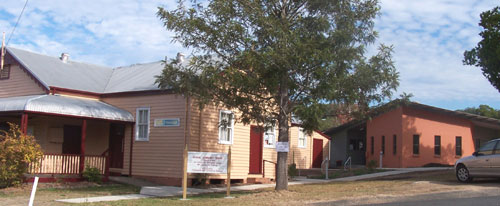
Kendall Community Centre 2006
Acknowledgements:
Heritage Impact Statement for RTC building – Elaine van Kempen
Photographs - Frank Kandilas, Mavis Barnes (in Kendall Community
Centre collection)
© Elaine van
Kempen 2006
Back |

